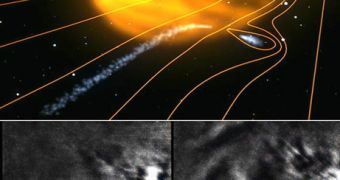Something that was witnessed for the first time by astronomers wreaked havoc in space: the impact between a comet and a solar hurricane. The cosmic crash was captured by a NASA Solar Terrestrial Relations Observatory (STEREO) satellite on April 20 and cut off the Encke comet's plasma tail while moving within Mercury's orbit.
"We were awestruck when we first saw these images. The surprise of seeing the disconnection of the tail was just the icing on the cake," said lead author Angelos Vourlidas, researcher at the Naval Research Laboratory.
Comets normally possess two Tails, one made of dust and another one which is less bright, consisting of electrically conducting gas named plasma. The Encke is a "repeating comet" that passes near the sun on a set interval.
Solar hurricanes (coronal mass ejections or solar flares) take place when the sun expels powerful eruptions of magnetized gas, traveling in space at speeds of over 2,000 mi (3,200 km) a second.
They are produced by massive explosions on the sun which lead to geomagnetic storms that can cause a lot of damage in communication, radio and TV signals, human-made satellites and Earth-based power grids, but fortunately most of them dissipate before reaching our planet, so that their damage amount is limited.
The fact that the solar hurricanes could have been the culprit behind comets' tail loss was only a supposition and this is the first time this is actually proved.
Investigating the cosmic impact, the astronomers found that the comet lost its tail through magnetic reconnection, the magnetic field of the comet being initially "crunched" by the magnetic field of the solar hurricane, but reconnected after that, spreading out a burst of energy that breaks off its plasma tail.
The unanswered questions refer to the amount of time required by Encke to get back a tail and whether the change will shift its orbit or not, turning it into a threat for our planet.
A similar, but less powerful event is the formation of the Aurora Borealis and Aurora Australis on Earth's magnetosphere.

 14 DAY TRIAL //
14 DAY TRIAL //